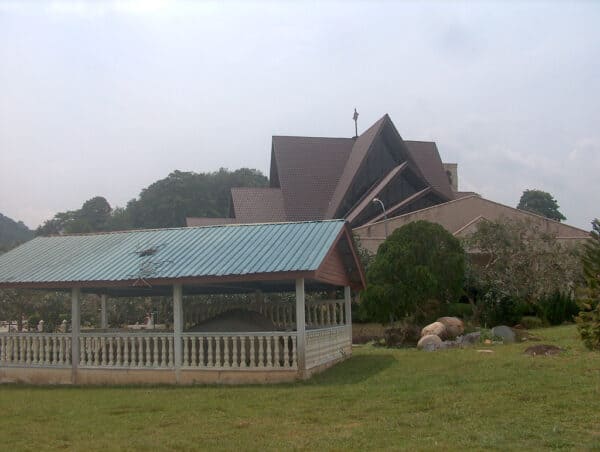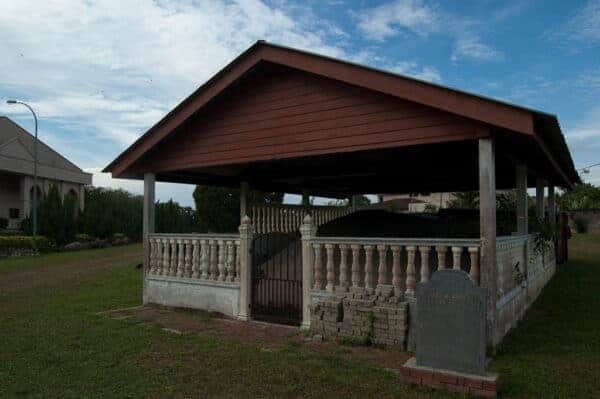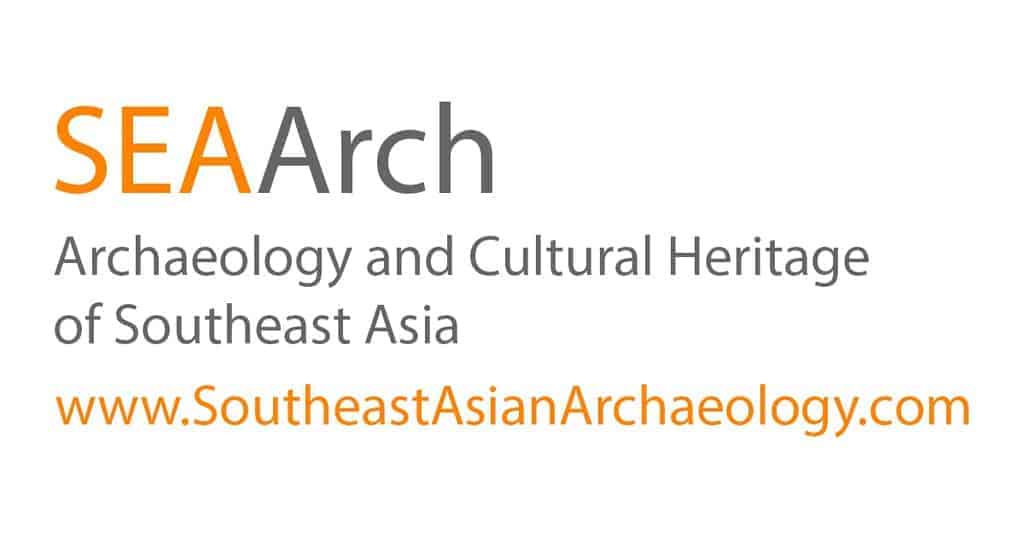Every year, thousands of Catholic pilgrims in Malaysia travel to the town of Bukit Mertajam in the mainland side of Penang to send petitions and thanksgiving at the Church of St Anne for her feastday on July 26. Since I live in Penang, the feastday celebrations are a great opportunity to be one of the pilgrims, and also to pay a visit to a lesser-known archaeological site, right in the grounds of the Church of St Anne itself: The Cherok Tok Kun Inscription.

All along the roads in mainland Penang, one comes across the brown sign (denoting a tourist attraction) pointing you to the Cherok Tok Kun Relics – but given the popularity of the annual St Anne’s Feastday celebration, I wonder why the signs just don’t point to the church and the relics at the same time. After all, you can’t find the relics without passing through the church – and once you actually get to the church you don’t actually see any signs pointing to the inscription.

The Cherok Tok Kun Relics lie on the quieter corner of the church, as most pilgrims would be drawn to the hillside shrine rather than the well-constructed shed that protects the relic. At this point I must say that ‘relic’ seems to be a bit of a misnomer – it’s really a large granite boulder with carved inscriptions on it. The sanskrit inscriptions are dated to around the 5th century, which is not surprising since we know that an Indianized settlement already have existed north of Cherok Tok Kun, in the Bujang Valley (about an hour’s drive from here), as early as the 2nd or 3rd century.

The Cherok Tok Kun is the southernmost inscription found in this region. I found out later that the boulder contains seven distinct inscriptions, although I only managed to find two. And it’s not a particularly big boulder, so I hope they haven’t been since erased. Perhaps if I return next year I’ll try to find the other five. The first inscription translates as prathame vayasi, or ‘in the time of youth’1, but I’ve got nothing on the second one. Any readers in ancient Sanskrit want to try their luck – or point out to me that it’s upside down2?
The boulder was discovered in modern times by an British East India Company officer, Colonel James Low in 1845. Of course, he just had to leave his mark too, along with many other vandals in the last 200 years.

Despite the grafitti, the site is quite well protected from the elements because of the shed. However, there doesn’t seem to be much else written about the relics. The official stone tablet set up by the Malaysian Museums and Antiquities department says it was discovered by James Low and the boulder was gazetted in 1973… but not much else. Amazingly enough, the small museum at the Church of St Anne, and even the book about the church’s history doesn’t even reference the inscription. Incredulous! You would think having a 1,500-year-old relic in your backyard would be worth mentioning.
Update: I am told that there is a translation of the inscription in Michel-Jacq-Hergoualc’h’s “La civilisation de ports-entrepôts du Sud Kedah (Malaysia)”. The French text book can be found here.



























Hey nice pics and info…..Very interesting indeed.
The first inscription(4th picture) do look like sanskrit(I don know sanskrit)…But the next one is definitely not.Its actually tamil or tamil-brammi.Cos i can partially recognise it.It reads something like “Se…….yar”.
Btw it could either be an ancient tamil inscription or some vandals recent work
try this…
http://en.wikipedia.org/wiki/BrÄhmÄ«_script
the script looks like Brahmi, it is from that period
Here’s J.W. Laidlay’s translation:
a. I acknowledge the enemies of the contented king Ramaunibha and the wicked are ever afflicted.
b. This is said by Manikatha, the protector of all great Buddhas.
c. In every form of life, knowledge becomes manifest everywhere and in every way.
d. Karma, which sports with passion, is the cause of transmigration.
[Source:
The Malay Peninsula: Crossroads of the Maritime Silk Road (2001) by Michel Jacq-Hergoualc’h, Translated by Victoria Hobson; Brill Academic Publishers, p.214]
Interesting find. The first inscription is no doubt of Brahmi script. The second one is Tamil script, very close to the modern script.It could be read as che…yar.
Hi,
1. I think probably only (a) in Jacq-Hergoualc’h (2001) is found on the Cherok Tokun Inscription. (b), (c) and (d) are probably the Buddhagupta Inscription, also found in Province Wellesley.
2. Arif is probably correct, the second one is probably vandals recent one.
3. The inscription, actually is a Pallava script, probably early Pallava. According to Laidlay, the language is Pali. I am still investigating, though (whether it is Pali or Sanskrit).
4. The fascimile of the seven distinct inscriptions are provided by Laidlay in his 1848 paper:
Laidlay JW (1848)
Note on the Inscriptions from Singapur and Province Wellesley forwarded by Hon. Col. Butterworth, CB and Col J. Low, JASB, XVII, 2:66-72
Anyone interested in taking a look at the fascimile or the paper (scanned pages) may contact me at rahula_80@yahoo.com
Regards,
Rahula
http://www.youtube.com/watch?v=mpYvDY00YIM
The fifth photo is in Modern Tamil script, perhaps late 19th century.
reads “selva mutaliyAr”
It is a name of an individual. It could be also “Sella mutaliyAr.” 3rd and 4th letters are not clear. “Sella” or “selva” is a male personal name. “mutaliyAr” is a title, also denotes a caste.